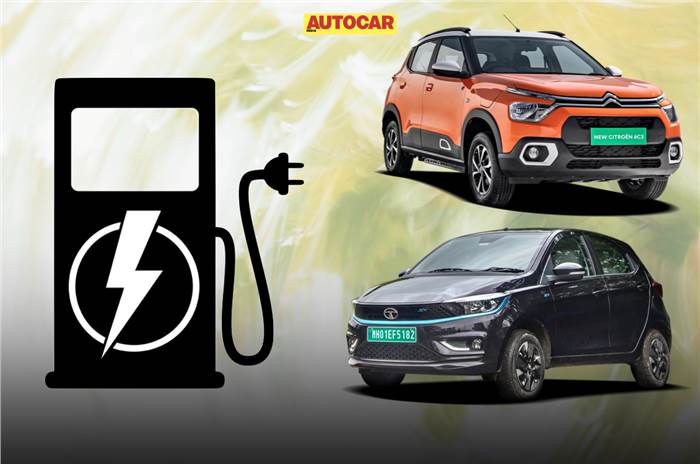eC3 has a claimed range of 320km while the Tiago EV returns a claimed 315km.
The Tata Tiago EV and the Citroen eC3 are currently the two most affordable four-door electric hatchbacks in the market – both fit in a Rs 12 lakh budget. Yes, the MG Comet is slightly more affordable than the eC3 and the Tiago EV, but its radical two-door form gives it a very narrow band of abilities, which is why we have left it out of this comparison.
Both the Tata and Citroen are direct ICE to EV conversions, and yet, are sensibly packaged with sufficient range for urban use. Here, we are comparing which of the two EVs return a higher real-world range, how fast they charge up and how efficient they are.
Tata Tiago EV vs Citroen eC3: powertrain, battery and specs
The Citroen eC3 is driven by an electric motor that makes 57hp and 143Nm of torque, and draws energy from a 29.2kWh battery. Tata offers a choice of two battery packs with the Tiago EV – 19.2kWh and 24kWh – and for this test, we have the larger one, which powers a 74hp, 114Nm motor. The former battery, meanwhile, powers a 61hp, 110Nm motor. The eC3 has a claimed range of 320km, while the Tiago EV returns a claimed 315km on a single charge.
As it is slightly larger in size, and has a larger battery, the eC3 is 166kg heavier than the Tiago EV. The Tiago EV gets four levels of regenerative braking, and while the eC3 also features brake energy recuperation, it is at a fixed level of retardation. So, that’s how both models fare on paper, and now, let’s find out how that translates to their respective real-world range.
Tata Tiago EV vs Citroen eC3: range and charging
Starting off with 100 percent charge, we drove both these cars back to back in similar conditions with periodic driver swaps, and at the end of our drive, both proved to be equally efficient and returned 7.8km/kWh, which translates to a real-world range of around 228km for the eC3 and 187km for the Tiago EV. In the end, the Citroen was left with 35 percent battery charge, while the Tata had 21 percent remaining.
On plugging both into a 30kW DC fast charger simultaneously, it was the Tiago EV, with its liquid-cooled battery that charged to 100 percent quicker, in 87 minutes, consuming 19.36kWh. The Citroen eC3’s larger air-cooled battery, meanwhile, reached full charge in 94 minutes and consumed 19.78kWh of power.
| Tata Tiago EV vs Citroen eC3 range | ||
|---|---|---|
| Citroen eC3 | Tata Tiago EV | |
| Battery | 29.2kWh | 24kWh |
| Power/Torque | 57hp/143Nm | 74hp/114Nm |
| Kerb weight | 1316kg | 1150kg |
| Claimed range | 320km | 315km |
| Tested Range | 228km | 187km |
| Efficiency | 7.8km/kWh | 7.77km/kWh |
Both cars come with a portable charging cable that can be plugged into a 15amp socket for a slow charge. However, Tata goes a step further and provides a 3.3kW AC wallbox charger along with the car as standard, and owners also get the option of a 7.2kW AC fast charger at an additional cost of Rs 50,000. Citroen doesn’t provide an AC wallbox charging option.
Tata Tiago EV vs Citroen eC3: price comparison
Prices for the Tiago EV range between Rs 7.99 lakh-11.89 lakh, while the eC3 is priced between Rs 11.61 lakh-13.41 lakh, both prices ex-showroom, Delhi. As we found out when the EVs went head-to-head, the premium the eC3 commands over the Tiago EV does get you more range and a more spacious interior, but the Tiago EV makes for an overall better package with far more equipment, livelier performance and better value too.
Also See:

























